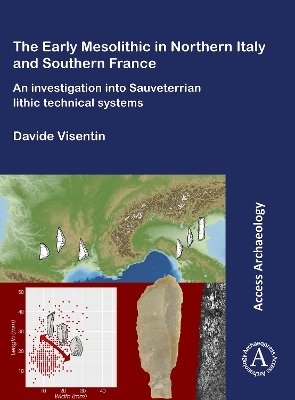
The Early Mesolithic in Northern Italy and Southern France
Archaeopress Access Archaeology (Verlag)
978-1-78491-927-6 (ISBN)
The Sauveterrian represents one of the main cultural aspects of the European Early Mesolithic. In this work, its presumed uniformity—mostly based on typological grounds—is questioned with the purpose of assessing and verifying the relationships existing between the two central areas of diffusion of this complex: southern France and northern Italy. A broad technological approach, combining complementary analytical techniques, was applied to the study of a series of French and Italian lithic assemblages. More specifically, these were investigated with the aim of reconstructing the entire reduction sequences, from the procurement of lithic raw materials to the use and discard of tools. Results indicate that the two regions responded to the same conceptual scheme and their respective lithic technical systems shared the same rationale: an extremely optimized technology, not opportunistic in the least, but issued from a careful strategic planning. Nonetheless, in the context of this generalized behaviour, a consistent variability can be found, marked by differences of both ‘stylistic’ and technical nature especially regarding the processes for producing microlithic armatures. At a general level, in the context of the important environmental changes that characterized the Late Glacial to Early Holocene transition, the emergence of Sauveterrian technology was fundamental in allowing the development of a complex settlement structure, characterized by a mobility system based on relatively short distances and with a strong logistic component.
Davide Visentin did his PhD at the University of Ferrara and at the University of Toulouse Jean Jaurès (co-directed thesis). His research and publication interests are focused on Late Palaeolithic and Mesolithic hunter-gatherers’ technology and settlement systems as well as mountain archaeology. He currently collaborates with the University of Ferrara on multiple research projects, directs the excavations at the Epigravettian site of Landro on the Cansiglio plateau and works as a field archaeologist in north-eastern Italy.
Foreword ;
Acknowledgements ;
Introduction ;
Geographic, archaeological and methodological setting ;
1 Regional setting ;
2 The Sauveterrian ;
3 Methodological framework ;
Studied sites ;
4 Grotte de Rouffignac ;
5 Fontfaurès ;
6 Baume de Montclus ;
7 Le Mose ;
8 Collecchio ;
9 Grottina dei Covoloni ;
10 Cima XII ;
11 Casera Lissandri 17 ;
12 Discussion ;
13 Conclusions ;
Appendix A Radiocarbon evidence ;
Appendix B Database value list and description ;
Bibliography
| Erscheinungsdatum | 01.11.2018 |
|---|---|
| Zusatzinfo | 96 illustrations, 167 tables |
| Sprache | englisch |
| Maße | 203 x 276 mm |
| Gewicht | 1156 g |
| Themenwelt | Sachbuch/Ratgeber ► Geschichte / Politik ► Vor- und Frühgeschichte / Antike |
| Geisteswissenschaften ► Archäologie | |
| Geschichte ► Allgemeine Geschichte ► Vor- und Frühgeschichte | |
| ISBN-10 | 1-78491-927-6 / 1784919276 |
| ISBN-13 | 978-1-78491-927-6 / 9781784919276 |
| Zustand | Neuware |
| Haben Sie eine Frage zum Produkt? |
aus dem Bereich


